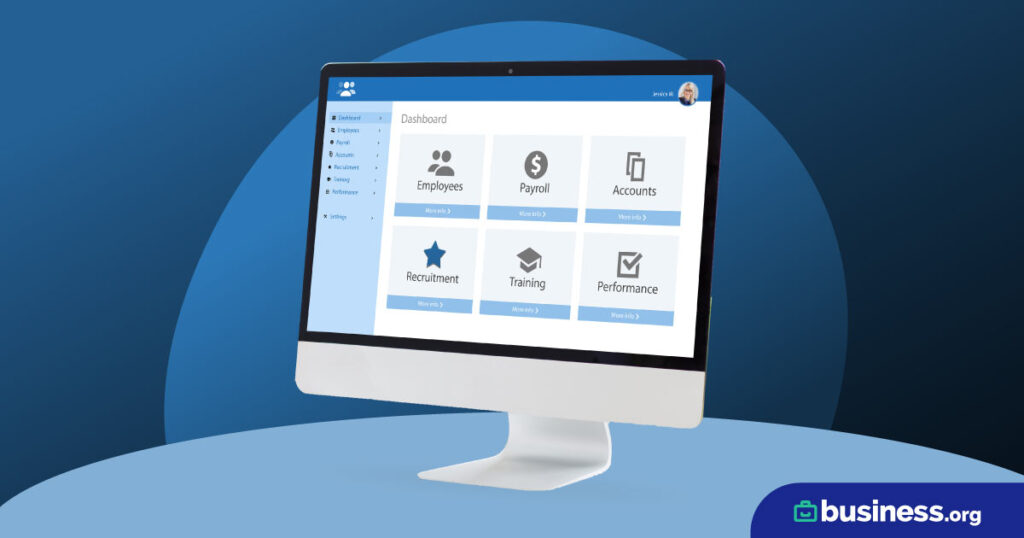We are committed to sharing unbiased reviews. Some of the links on our site are from our partners who compensate us. Read our editorial guidelines and advertising disclosure.
How to Do Payroll Yourself
Hiring an employee is an exciting step in growing your business, but running payroll requires a significant investment of time, money, and energy—and the penalty for mistakes is quite high.
Payroll software can take on most payroll tasks for you, and it can cost as little as $0 if you use free payroll software. But if you have above-average organizational skills and time to spare, you can also do payroll yourself with a payroll spreadsheet template and payroll calculator to ensure accuracy.
1. Apply for an EIN
An Employer Identification Number (EIN) is the business equivalent of a Social Security number. It’s a unique nine-digit number the Internal Revenue Service (IRS) uses to identify your business for tax purposes.
Some sole proprietors—a tax designation for business owners who attach Schedule C forms to their 1040 tax forms—simply use their Social Security number as their business identification number. (Sole proprietors can apply for an EIN, and it’s a useful way to ensure your business and personal finances stay separate, but it’s not legally required.)
However, once you’ve hired an employee, you must apply for an EIN. Otherwise, you can’t pay employee taxes or get proper tax identification for your expanding business. So if you need to pay employees, request an EIN today. (Heads up: household employers, such as parents who hire nannies, also need an employee identification number to pay employees.)
How to get an EIN
To get an EIN, visit the IRS’s website and file an online application. You’ll need to enter the following information:
- Your business type (e.g., a corporation, LLC, or sole proprietorship)
- Your business address
- Your reason for requesting an EIN (for instance, hiring an employee)
- Any additional details about your business
You can also register for an EIN by fax or mail, though registering online is faster. The IRS’s website lists fax numbers, mailing addresses, and other application options.
By signing up I agree to the Terms of Use and Privacy Policy.
2. Set a pay schedule
Once you have an EIN, you can start programming your payroll software to pay employees on a regular basis. Of course, to do so, you first need to decide how often you plan to pay employees.
Most businesses pay employees bi-weekly, meaning every other week.1 The next-most-common pay schedule is every week, followed by once a month and twice a month.1 So which schedule makes the most sense for your business?
The answer depends on your cash flow. Figure out how often you can afford to pay employees based on your profits—and don’t forget to include payroll expenses like direct deposit fees and stamps for mailing checks.
Before you finalize your pay schedule, check your state’s paycheck requirements too. For instance, Arizona requires you to pay employees at least twice a month, and it’s illegal to go more than 16 days without paying your workers.2
3. Calculate gross wages
Your hourly employees probably likely submit timecards to you or clock their hours via an app or time-tracking system like Square. Once you have your employees' hours for the pay period, convert minutes into wages to calculate each employee's gross pay amount.
Salaried employees typically earn the same amount each pay period. If you pay an employee a bonus, you need to use a separate bonus tax calculator, not a regular salary paycheck calculator, to calculate the right tax withholding amount—bonuses have slightly different tax requirements than typical paychecks.
Most paycheck calculators have you enter the employee’s gross wages YTD (year to date) before you can enter their gross wage for a specific pay period. Make sure you have that information on hand before you start calculating paychecks.
Finally, don’t forget about changes to employees’ typical work schedules, such as sick leave, paid time off (PTO), holidays, or discretionary time off (DTO).
While you're calculating your taxes and employee wages, remember to claim the ERC (Employee Retention Credit) to regain up to $26,000 per employee during COVID-19. Read more about how to claim this credit in our article: How to Claim the Employee Retention Credit (ERC) and Put Real Money Back in Your Business.
4. Calculate tax deductions
Now for the hardest part of running payroll: calculating payroll taxes, withholding those taxes from employee paychecks, and remitting that money to the federal government.
Federal and state income tax
To figure out income tax withholding amounts for each employee, you need the tax information they submit via Tax Form W-4. Your employees should fill out Form W-4 as soon as they're hired.
On the W-4, the employee lists information that determines their income tax payments:
- Whether they’re single, widowed, married and filing separately, or married filing jointly
- Whether the employee has multiple jobs, which impacts the percentage of tax withheld from each job
- Whether the employee’s partner works one or more jobs, which also impacts the amount of taxes withheld from the household as a whole
- Whether the employee has dependents, which qualifies them for certain tax benefits
- Whether the employee wants you to withhold additional taxes on their behalf
The final page of Form W-4 includes tax calculation tables that show you (and your employee) exactly how much will be withheld from their taxes based on allowances, income, and filing status.
While you can use the IRS’s tax withholding tables to calculate taxes by hand, we strongly recommend using a payroll calculator instead. With a payroll calculator or free payroll template, you don't have to do any math yourself—the calculator determines the right amount for you. As long as you've entered the data correctly, you don't need to worry about messing up a calculation.
If an employee gets married or divorced, has a child, or acquires a dependent (for instance, via marriage or adoption), they need to submit a new W-4 to update their tax withholding status. Business owners are legally required to update an employee’s tax information as soon as they submit their new W-4.
Along with federal income tax, you need to withhold state income tax (if your state has an income tax—some don't). Paycheck calculators can take care of these calculations too: just select the state in which your employee works from the calculator's drop-down menu. From there, the calculator should set the correct income tax withholding rate.
If you’re not using a paycheck calculator or a payroll system, visit the IRS’s list of state government websites. The state site will tell if your employee’s state has an income tax and, if so, how much.
FICA taxes (Medicare and Social Security deductions)
Along with income taxes, you need to withhold Social Security and Medicare taxes. Collectively , these are called FICA taxes, or Federal Insurance Contributions Act taxes. These taxes are charged a flat rate that applies equally to each employee.
For the 2023 tax year, the Social Security rate is 6.2%, and the Medicare rate is 1.45%, which totals 7.65% overall, with no increases since 2022.
Some employees are exempt from FICA taxes, such as foreign nonresident students working for a college or university. For the most part, though, employees are required to pay FICA payroll taxes.
If you’re not sure if any of your employees are exempt, speak with an accountant or other tax professional.
The total FICA tax rate is actually 15.3% of an employee’s gross wages, but employees only pay 7.65% of that amount. Employers, including household employers, pay the other half from the business's revenue. In other words, as an employer, you must match an employee’s FICA tax contributions dollar for dollar.
Don't want to calculate wages yourself (or be held responsible for withholding the right amount in tax deductions)? Payroll software can tackle the hardest parts of running payroll for you, including filing payroll taxes—and if you have fewer than 25 employees, you might be able to use completely free payroll software.
Interested? Enter some basic information about your payroll needs and business type, and we'll send you up to five customized payroll software quotes.
5. Make other common paycheck deductions
Taxes might not be the only thing you need to withhold from your employee’s paycheck. If your employees contribute to company benefits (for instance, if employees pay for their own insurance premium to use the health care provided by your company), you’ll withhold that amount directly from each paycheck.
Along with standard health insurance premiums, you might deduct other common withholdings from your employees’ gross pay:
- Court-ordered wage garnishments for child or spousal support
- Premiums for your company’s medical, dental, and vision plans
- Voluntary donations to charitable organizations
- Retirement fund contributions
Try a free payroll calculator
To use a paycheck calculator, you simply enter the information on your employee’s W-4. You then list the employee’s gross wages and select which state you’re filing from to calculate state income tax (if your state has one, which some don’t). The calculator automatically calculates the amount to deduct.
6. Distribute paychecks
Once you’ve determined how much each employee earned and how much you need to deduct, you can distribute employees’ take-home pay through a few different means.
Direct deposit is one of the most popular forms of paying employees. It tends to be more secure than handing out checks or cash, and it ensures employees with bank accounts can get their funds immediately.
If you decide to offer direct deposit, you’ll go through the Automated Clearing House (ACH), a US institution that monitors and manages all electronic, automated transfers from one bank to another. Your small-business bank can talk you through the process and help you set up automatic payments.
Usually, you’ll make direct deposit payments using your bank’s website (or with payroll software that syncs with your bank, like Gusto).
Not all banks or payroll systems offer next-day direct deposit, so you’ll usually need to schedule the payment before payday. Otherwise, your employees won’t get paid on time. Check with your bank on their direct deposit turnaround time before you run payroll the first time.
If you can, consider offering at least one payment option besides direct deposit:
- Cash
- Checks, including mailed checks
- Payroll cards
- Cash apps, such as the Square Cash App
7. Remit taxes and file end-of-year tax paperwork
Once you’ve deducted income, Medicare, and Social Security taxes from your employees’ paychecks, you’re responsible for making tax deposits to the IRS. You must also file the correct tax paperwork on time—though paperwork filing deadlines don’t always correspond to tax deposit deadlines.
As an employer, calculating taxes correctly, submitting them on time, and preparing the right forms must top your to-do list every month, not just during tax season. To stay on top of tax deadlines, we recommend talking to an accountant and creating a tax deadline calendar. If you miss a date, you’ll be subject to financial penalties, fines, and interest payments—none of which are great for your bottom line.
If you’re overwhelmed at the thought of tracking tax deadlines yourself, accounting software like QuickBooks Online usually includes quarterly tax payment reminders. Full-service payroll software automatically files taxes for you on the correct schedule, including pre-filled tax paperwork. And free or self-service payroll plans, which calculate paychecks and deductions for you but leave the actual filing up to you, often include perks like pre-filled W-2 forms and 1099 form filing.
Finally, a word to the wise: the general tax information we provide below doesn’t cover every tax form or filing deadline. To get in-depth, comprehensive information on your business’s tax obligations, consult IRS Notice 931 and read through the IRS’s list of employment tax due dates. You should also meet with an accountant to review your business’s specific tax obligations and filing due dates.
Federal income and FICA tax deposit schedules
Businesses can deposit income taxes either monthly or semi-weekly. You must decide on a tax-filing schedule before the calendar year starts. The type of deposit schedule you can choose depends on information you provide on IRS Form 941, which you use to report income taxes and submit your half of your employees’ FICA taxes.
If you’ve just launched your business and have never filed Form 941 before, you’ll automatically start out on a monthly tax-filing schedule. And as for how to deposit your employees’ taxes, the federal government requires you to use its electronic federal tax payment system (EFTPS) to file income taxes.
Quarterly tax forms
At the end of every quarter, employers need to submit Form 941, which summarizes your quarterly payroll tax deposits. These forms are due on the final day of the month directly following the quarter’s end. (The first quarter ends on March 31, so Form 941 is due April 30. The second quarter ends June 30, so Form 941 is due July 31.) If the last day of the month is a holiday or weekend, you can usually make the payment on the next business day.
The federal unemployment (FUTA) tax is a payroll tax on any business with employees, and it’s paid only by employers, not employees. You need to make your FUTA tax payments quarterly. Like Form 941, your FUTA tax deposits for the quarter must be made by the last day of the first month that follows the quarter’s end. By January 31 each year, you need to file Form 940, which summarizes your FUTA tax payments over the preceding tax year.
Other deadlines
Along with the forms and payments above, you also need to prepare W-2 forms for your employees, or Wage and Tax Statements, and distribute them no later than January 31. (You also need to prepare tax forms for most 1099 freelance contractors you’ve worked with, per IRS 1099 employee guidelines.)
Additionally, you likely need to submit employee W-2 forms to the Social Security Administration. You’ll include Form W-3 alongside your employee W-2 submissions to summarize employee wages and other key wage information.
To get a truly comprehensive look at when business taxes are due, review the IRS’s tax information hub for businesses. It breaks down tax deadlines by business type and size, lists all necessary forms and filing deadlines, and explains unique tax situations that apply only to niche industries like agricultural businesses.
Business income taxes and end-of-year tax write-offs
Along with typical employment and payroll taxes, most businesses need to file an annual income tax return. (Partnerships file information returns, not income statements.) Some aspects of payroll impact your business’s income-tax filing—especially in terms of deductions business owners can claim on their end-of-year tax forms.
A tax deduction, informally called a tax write-off, is an amount of money the government legally allows you to subtract (deduct) from your overall taxable income. If you have a lower taxable income, you pay less in taxes—which makes tax write-offs crucial to most small businesses’ financial stability.
How does this relate to payroll? Well, businesses can usually deduct their employees’ pay from their end-of-year taxes. Along with claiming employee wages on your end-of-year tax forms, you can deduct expenses related to retirement savings plans, like the cost of offering 401(K) plans for employees.
Health insurance costs for employees are generally deductible as well. And if you’re self-employed, you can write off 50% of the self-employment tax or the employer half of FICA taxes (self-employed business owners must pay both halves themselves.)
You can (and should!) read through the IRS’s full list of deductible business expenses to find other ways to save money on your end-of-year tax return. And, as always, speak with an accountant or other tax professional to maximize your write-offs.
Additional tax-filing information
To learn more about tax-filing deadlines for multiple business types, including LLCs, C corporations, and S corporations, read our page on how to file small-business taxes. You can also read through our list of this tax year’s filing deadlines for businesses.
Remember, the information above is far from an exhaustive list of your tax responsibilities as an employer. Like we said, it’s essential to read Notice 931 yourself and meet with a tax professional to talk through your business’s unique situation.
How to set up payroll for one employee
Business owners with just one employee are perfect candidates for free payroll software, payroll templates, and payroll calculators. With just one employee, you don't necessarily need the thorough payroll services you'd need with 50 or 100 employees.
However, the number of employees you hire affects how much time you spend on payroll, but it doesn't change the steps you take to run payroll. You'll need to follow the same steps listed above:
- Get an EIN
- Determine a pay schedule
- Calculate gross pay
- Calculate taxes
- Calculate other payroll deductions
- Give your employee their paycheck
- Keep detailed records and file taxes quarterly
The takeaway
Running payroll by hand is tricky—but it’s possible, especially for business owners on a budget and without too many employees to keep track of.
However, calculating payroll taxes and other deductions, filing the right amount in taxes, and getting your end-of-year tax forms filed on time are all complicated processes. And the stakes are high: your employees’ livelihood depends on correct payroll processing, and so does the IRS’s happiness with your business.
If you can, we strongly recommend investing in payroll software. If you have 25 or fewer employees, Payroll4Free lets you calculate paychecks and payroll tax deductions at no charge. (It even lets you print checks or set up direct deposit.) TimeTrex’s open-source software lets you calculate paychecks for an unlimited number of employees, and eSmart Paychecks enables check printing and unlimited paycheck calculations.
Self-service payroll plans start with monthly base fees as low as $10.00 (Patriot Software) or $19.99 (SurePayroll). And payroll companies like Square Payroll and Gusto offer contractor-only plans with no monthly base fee, just a $5 fee for each contractor paid per month.
Whether you use payroll software or calculate payroll by hand, accounting software can help you track the amount of money you spend on employee wages, tax payments, and other payroll-related fees. Read about some of our favorite accounting software solutions—including free accounting software, like Wave—on our list of the year’s best accounting companies for small-business owners.
Related reading
How to do payroll yourself FAQ
Yes, you can run payroll yourself by hand. The easiest way to run payroll yourself is with a payroll calculator, spreadsheet software, and a free payroll template with pre-filled cell formulas.
No, you don’t necessarily need a payroll service to do payroll. If you have no more than 25 employees, are confident in your ability to stay on top of tax deadlines, and have thorough organizational skills, you can likely do your own payroll.
Even if you have only one employee, payroll software from providers like Gusto and SurePayroll can dramatically simplify your life. An online payroll service will calculate paycheck amounts, deposit them directly into your employee’s bank account, and draw up tax forms for you to submit on time.
Plus, free payroll software performs the same tasks you do when you run payroll manually—they just do it faster, with more automation, and usually with a tax calculation guarantee that ensures your tax deductions are correct. Payroll software can save you money in the form of costly payroll mistakes—but perhaps more importantly, it can help you save the time you’d otherwise spend running payroll.
What is the best payroll software for small businesses?
Gusto is one of the best payroll software services for small businesses. It automatically calculates paychecks, withdraws taxes and makes other deductions, and pre-fills tax forms to submit at the end of the year. Gusto also has human resource management features like health benefits administration and workers comp insurance.
If Gusto doesn't seem like a good fit for you, there are dozens of other payroll solutions. SurePayroll is the most fully featured budget option, and it includes two free months for all new customers. ADP or Paychex are good options if you need HR benefits.
What is a payroll calculator?
A payroll calculator (also known as a paycheck calculator) is another way to make payroll easier without investing in software. All you need is your employee’s salary information and tax withholding status. The paycheck calculator crunches the numbers based on federal and state tax rates, including FICA taxes, and gives you the right net take-home pay.
What is a payroll journal entry?
A payroll journal entry is how you record and list payroll costs for your own books, meaning your own ledger and overall financial reports. A typical payroll entry includes a thorough record of your employees’ gross wages, tax deductions, and your own payroll taxes (typically FUTA taxes).
Payroll journal entries can be broken down to three key parts:
- Initial recordings include your employees’ wages and salaries, the amount deducted, and any payroll taxes you owe based on your employees’ salaries.
- Accrued wages are wages you haven’t yet paid an employee but will eventually turn into an initial recording.
- Manual payments are reserved for special circumstances like giving an employee a final paycheck.
To get a more in-depth look at payroll journals, take a look at our guide breaking down the topic. For now, just know that recording all payments made to employees in your general ledger is necessary for keeping your business in the black.
And while you can do payroll entries by hand, you can also use affordable online payroll software to simplify the process, minimize errors, and streamline your books.
Disclaimer
At Business.org, our research is meant to offer general product and service recommendations. We don't guarantee that our suggestions will work best for each individual or business, so consider your unique needs when choosing products and services.
Sources
1. US Bureau of Labor Statistics, “Length of Pay Periods in the Current Employment Statistics Survey,” January 1, 2022. Accessed December 8, 2022.
2. US Department of Labor, Wage and Hour Division, “State Payday Requirements,” January 1, 2021. Accessed December 8, 2022.






